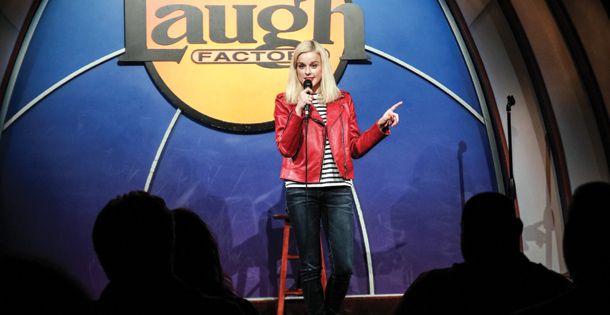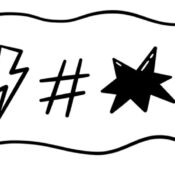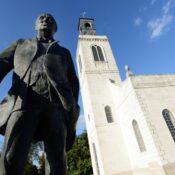The comedy gods have not been kind to Sioux Falls, South Dakota. Nitwits, Funny Bone, Wacko’s — the city’s three top clubs — all shut down in the last year or so, the yuks yielding to economic reality. But a new venue, called Boss’, has leapt in to fill the void. It’s situated inside a chicken-and-pizza joint. Seriously.
That’s almost funny — possibly even to the itinerant comics who count on the country’s club circuit for their livelihoods. It’s a peculiar bunch, these touring stand-ups. If they’re good enough, every weekend they climb on stage to deliver a set of jokes to a crowd that’s alcohol-primed and rowdy. It can be brutal.
And yet, Sioux Falls’ issues notwithstanding, club comedy is in the midst of a boomlet in America. The streets are alive with the sound of guffaws.
It’s no shocker, then, that wannabe comics are abundant. Where once kids coming out of college aimed to be hedge-fund traders, some of today’s grads actually see comedy as a legit option. That’s a crack-up, eh?
“You can make an amazing living doing stand-up, but you have to love it,” I was told by Bruce Smith, who heads Los Angeles-based Omnipop Talent Group, which mainly represents comics. “It’s a high price you’re paying.” By which he means the constant travel and the crummy hotels in which club owners frequently house their performers. “There are a lot of indignities in comedy,” Smith told me.
Andy Kindler knows from indignities — oy! — but also the unparalleled high of being on a stage with nothing but a handheld mic. Kindler is one of the fortunate ones, a comic who’s worked pretty much nonstop since 1987. “Overall, it’s a way better scene now,” Kindler said from his home in L.A. just before flying off to another gig. For one, social media has allowed comics to nurture their audiences. What hasn’t changed: the fun of mingling in the green room. “Hanging out with all the other comics keeps me sane.”
Typical of an ascendant stand-up whom Kindler might encounter backstage is Erica Rhodes, who was a little-known actress before deciding, five years ago, to take a shot at stand-up. At first, she told me, she was doing “bringer shows,” where you literally bring your own audience. It was degrading. Sometimes she bombed. There was no money. Things looked grim.
But who’s laughing now? Audiences aplenty. Today, Rhodes is a frequent headliner. She’s performed in at least 20 U.S. cities. (Plus she’s scored small parts on a few top TV shows, such as Modern Family and Veep.) On first seeing her name illuminated atop a club marquee: “It was cool, but it had no huge effect on me.” What? Like many comics, Rhodes has a hard time acknowledging success. The veteran Andy Kindler, who’s worked clubs with Rhodes, observed, “It’s a tough biz, but Erica’s doing it the right way. She’s been very relaxed.”
Rhodes is pleased — well, as pleased as a comic can be — to have broken through, despite the fact that it demands more travel. “Every club is so different,” she said. “And comics are all weird. Female comics can be cold to each other. Local comics can be arrogant. They all have insecurities.” Rhodes herself has an ample amount of those, which she readily confesses in her largely autobiographical act.
Will today’s thriving club scene last? Possibly. According to a recent Wall Street Journal story, “as the world becomes a more unsettling place, the comedy club becomes a haven of sorts.” And thus a predictable punchline: In especially troubled times, we Americans will go looking for laughter. Even, it would seem, in a Sioux Falls pizza parlor.
In the last issue, Neuhaus wrote about tattoos.
This article is featured in the May/June 2018 issue of The Saturday Evening Post. Subscribe to the magazine for more art, inspiring stories, fiction, humor, and features from our archives.
Become a Saturday Evening Post member and enjoy unlimited access. Subscribe now



